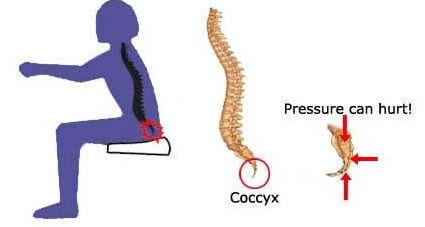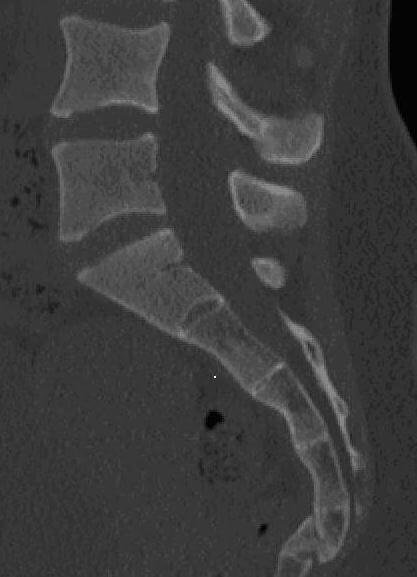What is Broken Tailbone?
Tailbone injuries are common among population, but fractures occur only occasionally. Tailed bone or coccygeal bone is a bone which consists of 3-5 vertebrae and is placed at the very end of the spinal column, in the back of the pelvis, between buttocks.

This location is one of the most common place of injury in many situations. Anyone can suffer this type of injury but some people with anatomical differences in the position of the coccyx may be more vulnerable than others.
Their coccyx is more prominent and curved to the back, away from the muscles on both sides. There is usually no dislocation of fractured fragments of the bone, but it takes some time to heal with supportive therapy.
Causes
Tailbone can be broken in various types of injuries:
- Sports injuries with sudden fall on the bone
- Sports injuries with constant pressure on the bone
- Child injuries with sudden drop or fall on a narrow, hard object
- Associated with other injuries, mostly sacral bone
- Birth injury and fracture
- Light trauma in elderly people with osteoporosis and vitamin D deficiency; they are more likely to slip and fall; underweight people with less muscle tissue around the coccyx have a higher chance to break the tailbone when falling.
- Car crash accidents.

Figure 1 Mechanism of impact in car accident (1)
There are three stages of the tailbone injuries: hypermobility, subluxation and fracture with dislocation. Not every injury has a risk of fracture. Women are four times more likely to experience coccyx fracture because of the increased risk factors (pregnancy, osteoporosis etc). (1)
The fracture may be complete or incomplete, and there is another type, a hairline fracture which is so small, that it isn’t noticeable on X ray, only on MRI or CT. It happens when the injury is minor. The fractures that occur in people with osteoporosis or some congenital anomalies of bones appear because of the fragile bones and lesser resistance to pressure. In healthy people these types of trauma would induce only bruised tailbone and pain (coccydynia).
Symptoms and signs
A person experiences acute, intensive and severe pain, which may even prevent him/her to walk, stand or sit. This location of the body is hypermobile, which induces pain with even the slightest movements.
A person also has some redness, bruising and swelling of the skin, with restriction of movements. Some people complain about problems during defecation or sexual intercourse. (2) In fractures, there is some cracking sound on movement. Sometimes there is a damage to the nerves which is why there could be numbness or tingling.
Diagnosis
Information about the injury or recent vaginal labour and pain are usually sufficient for diagnosis. To distinguish fracture from bruised tailbone, a doctor will palpate the area to check for a bulge, prominent bone parts or crepitations and change of position of coccyx from the midline. An additional X ray is performed to prove the diagnosis. Your doctor will also perform neurological, rectal exam and maybe some ultrasound, MRI, CT imaging techniques to exclude some other causes of pain in that area.

Figure 3 X ray of fractured tailbone with dislocation of fragments (3)
Signs of fracture on X ray are hypodense lines that are usually located at the junctions between the vertebrae or at the tip of the bone. If the injury is massive, the fracture lines may appear without any rule in any direction. The coccygeal bone may be comminuted in car accidents for example.
Treatment
The pain is at first treated with symptomatic and supportive measures: rest, analgesics, application of heat or cold, special cushions, a diet with a lot of fibres which would prevent constipation and treatment of osteoporosis. Physical therapy can also be useful in this type of injury, in order to strengthen the muscles around the coccyx and to improve stability. (3)
The vertebrae are left to heal on their own, because all the fragments remain in their place. If a doctor sees a misalignment on X ray he/she may attempt to straighten it, although this is not recommended and usually not done in practice, while even if the fragment is back on its place, the minimal movements would lightly put it back on the misaligned place, because immobilisation is impossible. The strong muscles of the pelvis will keep the fragments in their original place, and help with healing.
Surgical treatment is reserved for massive fractures and prominent fracture fragments, and includes removal of bone parts to prevent further damage to the tissue. After the pain becomes chronical, and lasts more than two months, it is also indicated to perform a surgical procedure to remove a part of coccyx.
Vertebroplasty is the modern method of reconstruction of the damaged segments. (3) However, the recovery after surgical procedure is long and painful, so the pro’s and con’s should be discussed before the decision is made.
Recovery time
Broken tailbone Recovery requires 10-12 weeks with rest and avoiding the painful activities and positions. However, it also recommended doing some exercises to strengthen muscles, which should be limited and without overdoing it. Sometimes the pain persists longer, in some people from a couple of months and up to a year.
Works Cited
- Doe report. [Online] [Cited: 2 27, 2017.] http://www.doereport.com/generateexhibit.php?ID=41&ExhibitKeywordsRaw=&TL=&A=.
- Surgical treatment of coccygodynia: an analytic review of the literature. Karadimas EJ, Trypsiannis G, Giannoudis PV. 2011, Eur Spine J. 20(5), pp. 698-705.
- Intrapartum coccygeal fracture, a cause for postpartum coccydynia: a case report. Kaushal R, Bhanot A, Luthra S, Gupta PN, Sharma RB. 2005, J Surg Orthop Adv. 14(3), pp. 136-7.
- Anyone with fractured coccyx and sacrum experience? coccyx.org. [Online] [Cited: 2 27, 2017.] http://www.coccyx.org/personal/2006/jennif.htm.
- Broken tailbone; coccyx fracture. PTREFER. [Online] [Cited: 2 27, 2017.] http://ptrefer.com/education/edu_inj/71/Broken_Tailbone__Coccyx_fracture.
- Coccygeoplasty: treatment for fractures of the coccyx. Dean LM, Syed MI, Jan SA, Patel NA, Shaikh A, Morar K, Shah O. 2006, J Vasc Interv Radiol. 17(5), pp. 909-12.

You did not report that a person that has a broken tail bone needs to go into the hospital for some time. I was in the hospital for 1 week with a bruised tail bone and it took several years before all the pain went away.
I “cracked” my tailbone at work. At first it was I’ll walk it off, but as the day went on my lower back was hurting bad. So I went to my supervisor and they sent me to get X-rays . It showed I my tailbone was fractured between 3 & 5. I hurt for more than 6 months. I couldn’t sit, or stand long. When I slept at night I had pillows under my legs to take pressure off my bottom.
When I had my son they said it wouldn’t be an easy delivery because the tailbone was curved inward. Luckily he was delivered normally but my tailbone was re-broken when he was delivered.
I “cracked” my tailbone at work. At first it was I’ll walk it off, but as the day went on my lower back was hurting bad. So I went to my supervisor and they sent me to get X-rays . It showed I my tailbone was fractured between 3 & 5. I hurt for more than 6 months. I couldn’t sit, or stand long. When I slept at night I had pillows under my legs to take pressure off my bottom.
When I had my son they said it wouldn’t be an easy delivery because the tailbone was curved inward. Luckily he was delivered normally but my tailbone was re-broken when he was delivered.